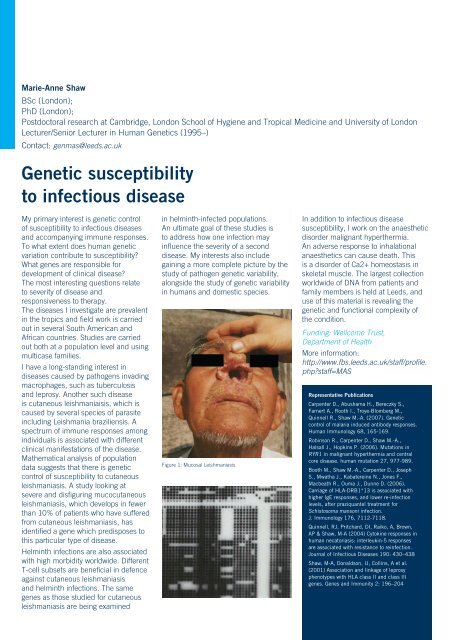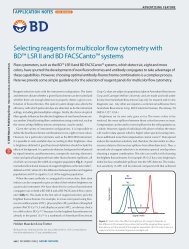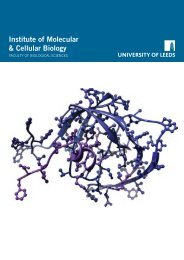3649-08 IICB.indd - Faculty of Biological Sciences - University of ...
3649-08 IICB.indd - Faculty of Biological Sciences - University of ...
3649-08 IICB.indd - Faculty of Biological Sciences - University of ...
Create successful ePaper yourself
Turn your PDF publications into a flip-book with our unique Google optimized e-Paper software.
Marie-Anne Shaw<br />
BSc (London);<br />
PhD (London);<br />
Postdoctoral research at Cambridge, London School <strong>of</strong> Hygiene and Tropical Medicine and <strong>University</strong> <strong>of</strong> London<br />
Lecturer/Senior Lecturer in Human Genetics (1995–)<br />
Contact: genmas@leeds.ac.uk<br />
Genetic susceptibility<br />
to infectious disease<br />
My primary interest is genetic control<br />
<strong>of</strong> susceptibility to infectious diseases<br />
and accompanying immune responses.<br />
To what extent does human genetic<br />
variation contribute to susceptibility?<br />
What genes are responsible for<br />
development <strong>of</strong> clinical disease?<br />
The most interesting questions relate<br />
to severity <strong>of</strong> disease and<br />
responsiveness to therapy.<br />
The diseases I investigate are prevalent<br />
in the tropics and field work is carried<br />
out in several South American and<br />
African countries. Studies are carried<br />
out both at a population level and using<br />
multicase families.<br />
I have a long-standing interest in<br />
diseases caused by pathogens invading<br />
macrophages, such as tuberculosis<br />
and leprosy. Another such disease<br />
is cutaneous leishmaniaisis, which is<br />
caused by several species <strong>of</strong> parasite<br />
including Leishmania braziliensis. A<br />
spectrum <strong>of</strong> immune responses among<br />
individuals is associated with different<br />
clinical manifestations <strong>of</strong> the disease.<br />
Mathematical analysis <strong>of</strong> population<br />
data suggests that there is genetic<br />
control <strong>of</strong> susceptibility to cutaneous<br />
leishmaniasis. A study looking at<br />
severe and disfiguring mucocutaneous<br />
leishmaniasis, which develops in fewer<br />
than 10% <strong>of</strong> patients who have suffered<br />
from cutaneous leishmaniasis, has<br />
identified a gene which predisposes to<br />
this particular type <strong>of</strong> disease.<br />
Helminth infections are also associated<br />
with high morbidity worldwide. Different<br />
T-cell subsets are beneficial in defence<br />
against cutaneous leishmaniasis<br />
and helminth infections. The same<br />
genes as those studied for cutaneous<br />
leishmaniasis are being examined<br />
in helminth-infected populations.<br />
An ultimate goal <strong>of</strong> these studies is<br />
to address how one infection may<br />
influence the severity <strong>of</strong> a second<br />
disease. My interests also include<br />
gaining a more complete picture by the<br />
study <strong>of</strong> pathogen genetic variability,<br />
alongside the study <strong>of</strong> genetic variability<br />
in humans and domestic species.<br />
Figure 1: Mucosal Leishmaniasis<br />
In addition to infectious disease<br />
susceptibility, I work on the anaesthetic<br />
disorder malignant hyperthermia.<br />
An adverse response to inhalational<br />
anaesthetics can cause death. This<br />
is a disorder <strong>of</strong> Ca2+ homeostasis in<br />
skeletal muscle. The largest collection<br />
worldwide <strong>of</strong> DNA from patients and<br />
family members is held at Leeds, and<br />
use <strong>of</strong> this material is revealing the<br />
genetic and functional complexity <strong>of</strong><br />
the condition.<br />
Funding: Wellcome Trust,<br />
Department <strong>of</strong> Health<br />
More information:<br />
http://www.fbs.leeds.ac.uk/staff/pr<strong>of</strong>ile.<br />
php?staff=MAS<br />
Representative Publications<br />
Carpenter D., Abushama H., Bereczky S.,<br />
Farnert A., Rooth I., Troye-Blomberg M.,<br />
Quinnell R., Shaw M.-A. (2007). Genetic<br />
control <strong>of</strong> malaria induced antibody responses.<br />
Human Immunology 68, 165-169.<br />
Robinson R., Carpenter D., Shaw M.-A.,<br />
Halsall J., Hopkins P. (2006). Mutations in<br />
RYR1 in malignant hyperthermia and central<br />
core disease. human mutation 27, 977-989.<br />
Booth M., Shaw M.-A., Carpenter D., Joseph<br />
S., Mwatha J., Kabatereine N., Jones F.,<br />
Macbeath R., Ouma J., Dunne D. (2006).<br />
Carriage <strong>of</strong> HLA-DRB1*13 is associated with<br />
higher IgE responses, and lower re-infection<br />
levels, after praziquantel treatment for<br />
Schistosoma mansoni infection.<br />
J. Immunology 176, 7112-7118.<br />
Quinnell, RJ, Pritchard, DI, Raiko, A, Brown,<br />
AP & Shaw, M-A (2004) Cytokine responses in<br />
human necatoriasis: interleukin-5 responses<br />
are associated with resistance to reinfection.<br />
Journal <strong>of</strong> Infectious Diseases 190: 430–438<br />
Shaw, M-A, Donaldson, IJ, Collins, A et al.<br />
(2001) Association and linkage <strong>of</strong> leprosy<br />
phenotypes with HLA class II and class III<br />
genes. Genes and Immunity 2: 196–204










